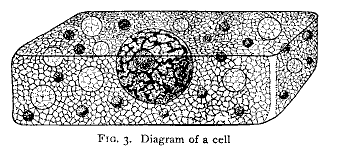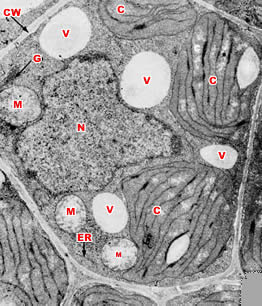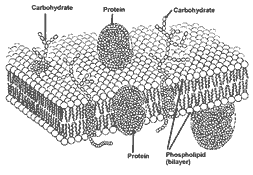If you
can visualize a living cell's life systems in terms of a factory,
production lines, processes directed by information, all working at
maximum capacity and top speed ... then life becomes redefined in an
entirely remarkable context. How could something called life
appear so well coordinated and designed?
| Only
with the discovery of the molecular basis of life has
science been able to address questions about life's basic
mechanisms. Science has learned over the past four decades
that the many cellular tasks required to sustain life are
carried out by machines—literally, molecular machines. Behe
(MC) Page 177 |
The
WindowView now enlarges cell details to think with a bit of wonder
about all the ultra-structures and inner workings of life. Take a
really close look at the finer scale to life and to dimensions that
make what's really small to have really huge implications! Every cell
in your body exhibits something incredibly well designed ... now
multiply that by the number of cells inside of you!
| The
human body, for example, has about 50 trillion cells. Spetner
(NBC) Page 25 |
We are
not talking about coordinating systems on any small scale. The number
of cells in one organism speak to the number of places where a
complete library of genetic information is stored. This number is also
indicative of the number of compartments that are interlinked and
structure into tissues and thereafter into organs that function in a
specific set of high order tasks to keep the larger organisms on
track, functioning, and alive to the next generation. Meanwhile, each
little compartment is a veritable array of functions and a master work
in its own right.
|
Consider
This:
From the dawn of
light microscopy's first glimpse into life, science had a general appreciation
for the presence of cells within living forms. In the 1600's light microscopes
were greatly enhanced by better lenses and greater magnifying power. But at no
time in all of human history was there ever a greater biological epiphany than
when electron microscopes began to reveal the incredible intricacy within
cells—from single celled organisms to cells in complex beings such as in our
own human bodies. In fact, it seems incredible that anyone looking at the
diagrams in a scientific weekly—such as Science or Nature—wouldn't
readily agree that cellular structures and associated biochemical pathways are
phenomenally organized and intricate. Every aspect of these publications'
illustrations suggests a sculpting and design on the smallest
scale—functional components working at the smallest of all possible levels.
|
Protein
molecules are the ultimate stuff of life. If we think of the cell as
being analogous to a factory, then the proteins can be thought of as
analogous to the machines on the factory floor which carry out
individually or in groups of all the essential activities on which
the life of the cell depends. Each protein is a sort of
micro-miniaturized machine, so small that it must be magnified a
million times before it is visible to the human eye. The structure
and functioning of these fascinating work horses of the cell was a
complete mystery until the 1950s. Denton
(ETC) Page 234
Each
enzyme is a single large protein molecule consisting of some several
thousand atoms linked together to form a particular spatial
configuration which confers upon the molecule the capacity to carry
out a unique chemical operation. Denton
(ETC) Page 334
|
But faced with what
seems the entirely inconceivable, scientists treat such detail as a fact of
the ordinary—but with a moment's deeper reflection—reveals the small
cellular details take on immense meaning. They are not ordinary. They are
entirely mechanical, but are well tailored to specific jobs, and perhaps
engineered beyond the reach of evolutionary natural selection and the supposed
gradualism that is implied to be the pathway of decent from ancestral life
forms. In fact what we call primitive cells embody complexities that are found
in the cells of more complex organisms.
Molecular
biology has shown that even the simplest of all living systems on the
earth today, bacterial cells, are exceedingly complex objects.
Although the tiniest bacterial cells are incredibly small, weighing
less than 10-12 gms, each is in effect a veritable
micro-miniaturized factory containing thousands of exquisitely
designed pieces of intricate molecular machinery, made up altogether
of one hundred thousand million atoms, far more complicated than any
machine built by man and absolutely without parallel in the nonliving
world.
Denton (ETC) Page 250 |
|
The complexity of
life is routinely paraded across the pages and illustrations of technical
weeklies entitled 'Science' and 'Nature.' Other periodicals—'Time,'
'Newsweek,' 'Scientific American,' et al. —make the same topics more
approachable by wider audiences. Yet a basic appreciation for what we all see
is lost in the technical descriptions. First, life is very complex and second
explaining the level of complexity we now observe is no simple matter ... it
begs questions concerning origin, design, and precision that exceeds chance.
Could primitive forms of molecules easily lead to the more advanced?
|
The
impossibility of gradual functional transformation is virtually
self-evident in the case of proteins:
mere causal observation reveals that a protein is an interacting
whole, the function of every amino acid being more or less (like
letters in a sentence or cogwheels is in a watch) essential to the
function of the entire system. Denton
(ETC) Page 321
|
How would one track
evolution of molecules to the current working protein in a cell? The
remarkable shape and specific site of activity on a protein (e.g., enzyme)
doesn't allow much room for scenarios where a lineage of nonfunctional
proteins would precede the functional entity. How does a life form function
based on an array of nonfunctional components. That's like saying a sentence
or meaning existed near it's origin with gibberish in place of intelligible
language. When does the gibberish turn into fully functional words? Can a
meaningful sentence exist as gibberish until the words are properly set in
place? Can production of non-functional protein be sustained while it is
transformed to its fully evolved state?
But amino acids in a protein
are not the same as moving letters or words around! Moving amino acids into
and out of a protein changes the entire scheme of bonds, the overall shape of
the molecule, and thus destabilizing the molecule to the point of being
useless. Meanwhile, proteins as enzymes do not work
alone. In this regard a coordinated series of changes would be required to
make life possible.
Life's
Machines, the Details
We've included a
diagram of a cell as it appears in a 1924 biology textbook (diagram
A). This is about as much detail as
Darwin could see in a light microscope available to him in his day. A living
cell might display inner streaming motion, but the detail within revealed
nothing more than randomness, globules, particles, or variations in indistinct
shape and color.
With the advent of
electron microscopes and more sophisticated light microscopy, the cell takes
on an entirely different appearance. We can now magnify the cellular details a
thousand million times ...
|
...
until it is twenty kilometers in diameter and resembles a giant
airship large enough to cover a great city like London or New
York. What we would then see would be an object of unparalleled
complexity and adaptive design. Denton
(ETC) Page 328
|
Look to the right of
the (Fig 3.) "Diagram of a cell" (diagram A)
below and you'll find an image from an electron microscope (diagram
B). This photo is not magnified
nearly as much as an electron microscope can do. But look at the line drawing
of the membrane below this photo image (diagram C).
The two layers of molecules that make up the membrane sheet and the large
protein or carbohydrate molecules that extend into or across the membrane are
our current refined view of life's highly ordered appearance.
Give those molecules
all their specific jobs and add the rates of speed at which they service the
cell or tissues around them and this static picture just zooms with activity
and remarkable efficiency. Darwin and science—until shortly after World War
II—had no clue of life at the molecular level.

A:
An artist's representation (above) of the cell from the turn of the
Twentieth Century. The amount of detail is limited, much like what
was available to scientists to scrutinize in Darwin's day.
|
 B B
|
|
B:
An electron microscope (EM) image form a plant cell—many thousands
of times beyond the magnification made possible by a light microscope.
C:
Electron microscopy, along with advances in biochemical research, now
makes it possible to understand a membrane of a cell, its structure
down to single molecular components, and the function of each type of
molecule.
|
C |
However, take the
images and science data that accompany the structural and functional aspects
to what we see and add a bit of poetic license AND the whole picture consumes
our imagination to describe a reality that is way beyond our daily
perception. But this describes the inner workings of our material being. Let's
take a look as Dr. Denton moves from the outer membrane of a cell to the inner
parts of this compartment of life.
| On
the surface of the cell we would see millions of openings, like the
portholes of a vast space ship, opening and closing to allow a
continual stream of materials to flow in and out. If we were to
enter one of these openings with find ourselves in a world of
supreme technology and bewildering complexity. We would see endless
highly organized corridors and conduits branching in every direction
away from the perimeter of the cell, some leading to the central
memory bank in the nucleus and others to assembly plants and
processing units. The nucleus of itself would be a vast spherical
chamber more than a kilometer in diameter, resembling a geodesic
dome inside of which we would see, all neatly stacked together in
ordered arrays, the miles of coiled chains of the DNA molecules. A
huge range of products and raw materials would shuttle along all the
manifold conduits in a highly ordered fashion to and from all the
various assembly plants in the outer regions of the cell.
Denton (ETC) Page 328 |
Proteins are key
mechanical components in life. They are like the cell's engineered
automatons—specific tooled machines—displaying astonishing complexity
based on thousands of atoms that uniquely make specific functional
three-dimensional configurations.
| When a
number of enzymes are necessary for the assembly of a particular
compound, they are arranged adjacent to each other so that, after
each step in the operation, the partially completed compound can be
conveniently passed to the next enzyme which performs the next
chemical operation and so on until the compound is finally
assembled. The process is so efficient that some compounds can be
assembled in less than a second, while in many cases the same
synthetic operations carried out by chemists, even in a
well-equipped lab, would take several hours or days or even weeks. Denton
(ETC) Page 334
The cell,
however, manufactures all its component structures, even the most
complex, by fully automated assembly techniques which are perfectly
regulated and controlled. Unlike our own a pseudo-automated assembly
plants, where external controls are being continually applied, the
cell's manufacturing capacity is entirely self-regulated. Denton
(ETC) Page 335
|
Whoa ... hold on
tight ... not only is the machinery intricate, the efficiency of the way these
molecules work is at WARP speed. What goes on at the cell level can be
mimicked but not be reproduced in a modern laboratory. And there is the sense
that all this is directed. So, beyond the physical presence of all the cell
components is the issue of the information that drives all processes to
sustain life at all levels.
|
We
would see that nearly every feature of our own advanced machines had
its analogue in the cell: artificial languages and their decoding
systems, memory banks for information storage and retrieval, elegant
control systems regulating the automated assembly of parts and
components, error fail-safe and proof-reading
devices utilized for quality control, assembly processes involving
the principle of pre-fabrication and modular construction. In fact,
so deep would be the feeling of deja-vu, so persuasive the
analogy, that much of the terminology we would use to describe this
fascinating molecular reality would be borrowed from the world of
late twentieth-century technology. Denton
(ETC) Page 329
|
We can think of the
cell as a marvelous factory, full of activity, speed, efficiency, and modular
sub-unit of tissues and organs in the body. But there is one more remarkable
feature that exceeds the likes of a typical factory. The cell is able to
completely replicate itself within a matter of hours. What
machine or factory is capable of that! The cell, as a factory,
surpasses anything engineered by human material production platforms.
LET'S
MAKE A MODEL!
Dr. Denton suggests we think in terms of
constructing an atomic model of the cell. Take one atom at a time and simply
put it into the model. How long would it take to build the model?
A typical cell contains some
ten million million atoms.
| Suppose
we chose to build an exact replica to a scale of one thousand
million times that of the cell so that each atom of the model would
be the size of a tennis ball. Constructing such a model at the rate
of one atom per minute, it would take fifty million years to finish,
and the object we would end up with would be the giant factory,
described above, some twenty kilometers in diameter, with a volume
thousands of times that of the Great Pyramid. Denton
(ETC) Page 330 |
Denton further elaborates on
this model to show how construction of the cell might take less time. However,
even with some advantages in model building the concludes: "Working
continually day and night it would still be difficult to finish the model in
the space of one million years."
Less we forget ... we can
marvel at the complexity and construction of a cell, but there are staggering
issues to comprehend when we move on to an organ such as a mammal's brain!
|
... The human brain
consists of about ten thousand million nerve cells. Each nerve cell
puts out somewhere in the region of between ten thousand and one
hundred thousand connecting fibers by which it makes contact with
other nerve cells in the brain. All together the total number of
connections in the human brain approaches 1015 or a
thousand million million. Numbers in the order of 1015
are of course completely beyond comprehension.
Despite the
enormity of the number of connections, the ramifying forest of the
fibers is not a chaotic random tangle but a highly organized network
in which a high proportion of the fibers are unique adaptive
communication channels following their own specially ordained
pathway through the brain. Even if only one hundredth of the
connections in the brain and were specifically organized, this would
still represent a system containing a much greater number of
specific connections than in the entire communications network on
Earth. Denton
(ETC) Page 330
|
Denton's
quotation comes from the mid-1980's, so, perhaps it's only fair to say his
estimate for human communication systems is in need of a slight adjustment due
to the more recent advent of the Internet. Lets say two
or three hundredths were
specifically organized ... the brain still far exceeds our
global connections.
Earlier in the
WindowView Science Area narrative, there is the strong suggestion that the
universe, chemical origin to life, evolution, and many other perspectives
leave us hard pressed to conclude the cosmos and life within are by chance or
random process. Add to this ... scientists marvel over the architecture and
function of the brain. Science has yet to discover so much about the brain,
yet the structure alone is a clear testimony to design!
| Undoubtedly,
the complexity of biological systems in terms of the sheer number of
unique components is very impressive; and it raises the obvious
question: could any sort of purely random process ever have
assembled such systems in the time available? Denton
(ETC) Page 331 |
Magnifying a
cell—to allow our tour inside—is again a structural experience. The
information housed inside speaks to yet another marvel.
In a separate
feature
article we illustrate the incredible nature of DNA to store, replicate,
and transport information. The storage capacity alone for DNA ...
|
...
is so efficient that all the information needed to specify an
organism as complex as man weighs less than a few thousand
millionths of a gram. The information necessary to specify the
design of all the species of organisms which have ever existed on
the planet, a number according to G. G. Simpson of approximately one
thousand million, could be held in a teaspoon and there would still
be room left for all the information in every book ever written. Denton
(ETC) Page 334
|
Life is based on the
inner workings of biochemical molecular machines. Embrace the material
existence you live today and leave room to wonder, be awe struck, and consider
that you are the object of what is in fact so remarkable! Life, indeed, is
special!
|
